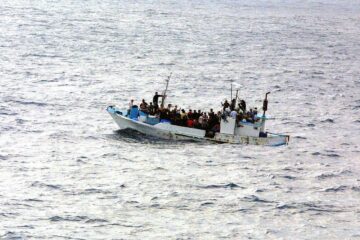![]()
Introduction:
Nepal has always acted as a buffer state between the Indian subcontinent and China. India and Nepal share a lot of history with respect to borders. The Indo Nepal border came under strain in 2019 when the Indian Home ministry released a new edition of the Indian map, showing the territory of Kalapani within Indian borders, after the abrogation of Article 370 &35A of the constitution.
To this Nepal stated that “The Nepal government firmly believes that the Kalapani is a part of Nepal. The Nepal government is determined on its principled position that such border disputes with the neighbouring countries should be resolved through diplomatic channels after assessing the historical documents, facts, and evidence.”[1]
In response to this, the Indian ministry of external affairs issued a statement that “Our map accurately depicts the sovereign territory of India. The new map has in no manner revised our boundary with Nepal”.[2] The border dispute once again got heated up after the defence minister of India inaugurated the Darchula-Lipulekh pass link road recently, an 80 km link road that cuts across Kalapani.
The main reason why India made the link-road that it would ease Pilgrims going to Kailash Mansorawar[3] through Sikkim and reduce the travel considerably. Besides that, it would help India transport troops into China, as and when required. From Nepal’s Standpoint, Chinese goods have to take a circuitous route into Nepal as Himalayan ranges cause obstruction. This Link would actually ease their trade with China and they wouldn’t have to rely solely on India.
This article aims to explore the historical background, treaties signed and why the area of Kalapani is an area for conflict.
Historical Background of the Border
After the fall of the Moghul empire, the Gorkha came to power and started expanding their borders, whose rule in the 18th century stretched as far as Sikkim in the east and Garhwal and Kumaon, a region in Uttarakhand, in the west. By the late 18th century, the English East India Company (EIC) grew in power and expanded its control over territories. By the 19th century, as the EIC began expanding northwards in Awadh, it came in close conflict with Palpa, an independent town within the Nepalese territory. This led to a border dispute between the Nepalese rulers and the British. The Nepalese rulers also hindered British trade with Tibet.
In the year 1814, the British declared war on Nepal. The war went on for two long years. The British general, Sir David Ochterlony, managed to drive out the Nepalese rulers from Garhwal and Kumaon.[4]
The Treaty of Sugauli 1816 and alliance between the Nepalese King and the British 1857
The Anglo Nepal war came to an end with the signing of the treaty of Sugauli in the year 1816. As explained by Whelpton, the treaty “required Nepal to give up all territories west and east of its present-day borders, to surrender the entire Tarai and to accept a permanent British representative (or ‘resident’) in Kathmandu[5]”.
According to the 5th clause in the treaty, “The Rajah of Nepal renounces for himself, his heirs, and successors all claim to or connection with the countries lying to the west of the river Kali and engages never to have any concern with those countries or inhabitants thereof.”[6]
In 1857 during the first war of Independence, the king of Nepal offered to help the EIC to control the situation. The Nepali troops had a large role to play in helping the British to crush the revolt & recapturing of Lucknow. In return, the British government gave away a large part of Western Terai including Janakpur & Kapilvastu to Nepal in a subsidiary treaty and alliance but the western boundary of Nepal saw no change and the border remained as the Kali river.[7]
Cause of Dispute with India
After the treaty was signed River Kali marked the western border of Nepal however there is an ongoing debate that is ongoing with regard to the precise location of the river Kali giving rise to the present debate that is whether the land that consists of the area of Kalapani-Limpiadhura-Lipulekh is part of the territory of Nepal.
According to Nepali scholars and experts, the east of the Kali river should begin at the source of the river the source according to thems in the mountains near Limpiyadhura, which is higher in altitude than the rest of the river’s flow. Nepal claims that a landmass, high in the mountains that falls to the east of the entire stretch starting from Limpiyadhura downwards, is theirs. Contrary to this India claims that the border begins at Kalapani which India says is where the river begins. The main cause of the dispute is the different interpretations of the origin of the Kali river and its various tributaries that cut through the mountains. While Nepal’s claim of the territory east of Kali is based on the Limpiyadhura origin, India claims that the river actually takes the name Kali near Kalapani.[8]
Importance of Lipulekh Pass
The region extends into the Himalayan region and is connected to the other side of the mountain region through the Lipulekh pass, which is to be used by Indian pilgrims to the Kailash Mansorawar. The Himalayan passes connect the Gangetic region to the Tibetan plateau. Lipulekh is strategically located near the national capital region which may be a concern in case of an armed conflict with China. As used by China in the 1962 war where the Chinese forces used the Se La pass in Tawang to transport their troops into the Bramahputra plains the military defeat in the east showed that the passes were a major vulnerability against China. Lipulekh was the most vulnerable. The 80 km road is actually built to easily transport troops into China. [9]
Nepal is currently dependent on India for all trade routes into Nepal comes through Uttar Pradesh, Uttarakhand, Bihar. Chinese Trade route is via Air-Freight or by Ships via Kolkata, as the Himalayas come in between Nepal and China. Hence the Lipulekh Pass opens up the Chinese Trade route for Nepal.
Nepal claims regarding Lipulekh
Various Nepali analysts claim that King Mahendra was worried that India would forcefully take the region of Kalapani to secure the Mountain pass. He reached an agreement with the Indian government that the region could be used by Indian forces for security purposes. According to another interpretation, India, worried over an aggressive China in the 1950s, got the King of Nepal to agree to a proposal to station 18 military outposts along Nepal’s northern frontier. In 1969, under bilateral negotiations, all the posts were removed barring Kalapani.[10]
Nepal is concerned over the fact that during the 2015 Lipulekh agreement between China and India which reinitialised India’s Mansarovar pilgrimage connection, neither consulted Nepal before reaching an agreement.
The Nepalese government claims to follow the treaty of Sugauli but according to Uddhab Pyakurel of Kathmandu University, Prime Minister Pushpa Kamal Dahal “Prachanda” for example, had indicated frustration with the Treaty of Sugauli after his Prime Ministerial stint in 2009 saying that the treaty had become irrelevant and championed the cause of a Greater Nepal going into the region west of the Kali.[11] This, in fact, shows that the statements issued by the Nepalese government are inconsistent with one another.
Present Situation
On 20th May,2020 Nepal published a new map. This map shows the areas of Lipulekh, Kalapani, and Limpiyadhura as part of Nepal. To this India reacted strongly wherein a statement by the external affairs ministry of India said “This unilateral act is not based on historical facts and evidence. Such artificial enlargement of territorial claims will not be accepted by India. Nepal is well aware of India’s consistent position on this matter; and India urges the government of Nepal to refrain from such unjustified cartographic assertion and respect India’s sovereignty and territorial integrity.[12]“
It is also notable that the Indian Army has 39 battalions serving in 7 Gorkha Regiment in the Indian Army. The troops are mainly from ethnic Gorkha community of Nepal. They have a history of courage in battle, evident from the gallantry awards Gorkha soldiers won; and battle honors awarded to Gorkha both before and after joining the Indian Army. On May 22nd the Nepalese Prime minister K P Oli led a cabinet proposing a constitution amendment motion; that is to grant constitutional validity of map by revisiting and amending section 3 of the constitution of Nepal.[13]
The lawmakers of Nepal unanimously endorsed the proposal for considering a constitutional amendment. The approval of the bill is significant in the house of representatives as the K.P. Oli government doesn’t enjoy the majority in the lower house.[14] There is a rare unity between the political parties for this particular amendment as India delays talks with Nepal.
Conclusion
The deputy PM of Nepal and Défense Minister, Ishwar Pokhre, said that ”We will solve the border issue through dialogue with India.”[15].
We sincerely hope that the tension between both the parties resolves through dialogue; as is evident from both the countries because doing anything unilaterally will only add to the fire. The world is already suffering due to the COVID-19 pandemic. In these trying times, India & Nepal needs to come together and discuss & resolve the border issue. Opportunities of the future dominate Indo-Nepal ties, not frustrations of the past.
References:
[1] Mohan, G. (2019, November 7). Kalapani an integral part: Nepal objects inclusion of unresolved territory as part of India in new maps. Retrieved June 10, 2020, from https://www.indiatoday.in/india/story/nepal-objects-kalapani-inclusion-new-india-map-jammu-and-kashmir-article-370-1616458-2019-11-07
[2] Pti. (n.d.). Our map accurately depicts India’s sovereign territory: MEA on Nepal’s objections: India News – Times of India. Retrieved June 10, 2020, from https://timesofindia.indiatimes.com/india/new-map-accurate-no-change-in-boundary-with-nepal-mea/articleshow/71956607.cms
[3] Bhattacherjee, K. (2020, May 24). Why are India and Nepal fighting over Kalapani? Retrieved June 10, 2020, from https://www.thehindu.com/news/national/why-are-india-and-nepal-fighting-over-kalapani/article31660401.ece
[4] Roychowdhury, A. (2020, May 27). Mapping the history of Kalapani dispute between India and Nepal. Retrieved June 11, 2020, from https://indianexpress.com/article/research/mapping-the-history-of-kalapani-dispute-between-india-and-nepal-6423687/
[5] Supra in 4th citation
[6] 5th clause in the treaty of Sugauli
[7] Demystifying the road in the heart of the Indo-Nepal border dispute. (n.d.). Retrieved June 11, 2020, from https://www.nationalheraldindia.com/india/demystifying-the-road-in-the-heart-of-the-indo-nepal-border-dispute
[8] [9] [10] [11]Supra 3rd citation
[12] Pti. (2020, May 20). India reacts sharply to Nepal releasing new map, calls it unjustified cartographic assertion: India News – Times of India. Retrieved June 11, 2020, from https://timesofindia.indiatimes.com/india/india-reacts-sharply-to-nepal-releasing-new-map-calls-it-unjustified-cartographic-assertion/articleshow/75852609.cms
[13] Supra in 3rd citation
[14] Parashar, S. (2020, June 10). Nepal Parliament moves to approve new map – Times of India. Retrieved June 11, 2020, from https://timesofindia.indiatimes.com/world/south-asia/nepal-parliament-moves-to-approve-new-map/articleshow/76290511.cms
[15] Al Jazeera. (2020, June 9). Nepal calls for border talks with India as row over map deepens. Retrieved June 11, 2020, from http://www.aljazeera.com/news/2020/06/nepal-calls-border-talks-india-row-map-deepens-200609112404591.html



1 Comment
Ram K · 15/06/2020 at 7:43 PM
Very nicely written Ushnish. Succinctly captures the history and nuances of the issue and lays it out for a lay reader like me. Thanks!!